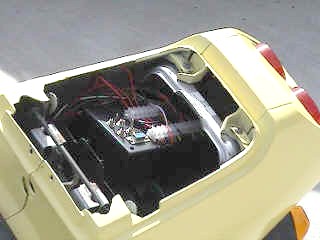The CBR250Ri
First Steps
Home
CBR
1
2
3
4

Once we’d sorted out a way of delivering a fine spray of motion lotion to the back of the valves we needed a fast ECU to deliver just the right amount at just the right time. Nobody out there on Planet Sanity is making a fuel injected engine spin at 18,000rpm except for the boys and girls in Formula One. We tried asking Ferrari if we could borrow a spare black box or two to tinker with, but they didn’t answer our emails. Funny, that. Aftermarket ECU manufacturers like MoTec make systems that can handle up to about 15,000rpm, but they cost too much, and, let’s face it, 15 just isn’t the same as 18, no matter what Steve’s lawyer tried to tell the jury.
Against our better judgement, we let Richard build a custom ECU. He blew up quite a lot of gear, but eventually he produced a serviceable unit based on a Zilog Z8 Encore (which boasts 80 pins of peripheral heaven). He claimed it would be able to run the injection system, variable ignition timing, all the other electrickery that’s currently on the bike, any stray NASA equipment that happened to drop out of the sky and quite a lot more besides, but we were sceptical. You would be too if you heard him raving about the feature he was most proud of – a “blinky LED”. Big deal, it can make a diode flash twice a second. And it takes up the entire storage area under the pillion seat. And Richard calls THIS a triumph of miniaturisation?*
After a visit to the air compressor, it became apparent that the fuel injection had done wonders for the engine’s low-down torque. The CBRi would quite happily pull straight up a 1-in-3 incline at 2,000rpm, no clutch. A stocker would need at least 6,000rpm on board and serious clutch abuse to get up the same slope. Impressive!
Once we were back on the road, testing speeds increased above walking pace and it became obvious that there was a fault in the ECU. The bike was just starting to get going properly when it ran into an artificial rev limiter at 10,000rpm. It was just like a lorikeet smacking into a window at Warp Factor Six, but with less squawking. We immediately accused Richard’s beloved Zilog of being too slow and clunky to blink the blinky LED and the injectors at the same time, but Neil eventually traced the problem to the software. He changed two lines of code and the restriction was gone.
He was right, though. The CBRi still had some flat spots below 10,000rpm, but once the engine got into the fun zone it just didn’t stop. Stock CBRs have a distinct peak at 16,000rpm and then the power drops away slightly, but the CBRi just kept on keeping on right into the revlimiter. Actually, the limiter was becoming a bit of a hazard in the lower gears because the bike got there so fast and decelerated so violently when the ignition was cut that it nearly threw the Crash Test Idiot over the fairing. Not only that, the induction roar from the free-flowing intake system completely masked the screaming exhaust note. Yes, we know that’s what Honda made the tacho for, but we prefer to keep our eyes on the road, thanks.
 Although our injection system made the bike go better than Mr Honda’s
carburettors, there were a few annoying problems with the system. Cold
starts were very difficult and the bike had to run incredibly rich until
it was warm. It didn’t idle particularly well. It fouled plugs at the
slightest opportunity. If the ECU lost power for even a millisecond, the
fuel map was gone forever. All normal development problems, and not really
difficult to fix. And as it turned out, we sorted out those particular
problems quite easily, but in doing so we introduced a heap of other problems…
Although our injection system made the bike go better than Mr Honda’s
carburettors, there were a few annoying problems with the system. Cold
starts were very difficult and the bike had to run incredibly rich until
it was warm. It didn’t idle particularly well. It fouled plugs at the
slightest opportunity. If the ECU lost power for even a millisecond, the
fuel map was gone forever. All normal development problems, and not really
difficult to fix. And as it turned out, we sorted out those particular
problems quite easily, but in doing so we introduced a heap of other problems…* Actually, the Mk II ECU was indeed a triumph of miniaturisation compared to the Mk I we used on the GRi. The Mk I took up half a workbench and was held together with sticky tape and hope.